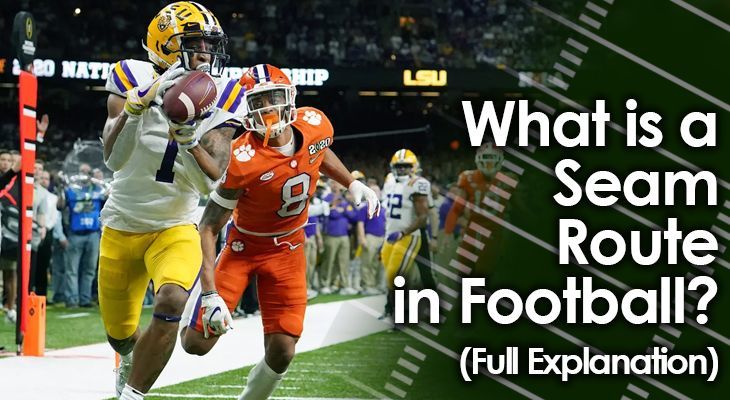The Seam route is one of the most effective passing routes that can be run by an inside receiver in football.
Unlike some of the other basic passing routes, the Seam route refers to the position on the field from which it's run rather than the actual route itself.
It's a passing route that's run "between the numbers" by either a tight end of an inside slot receiver.
The design of the route (as we'll soon see) is similar to other routes.
When used in combination with some of the other basic passing routes on the route tree, the Seam route can be particularly effective against zone defensive coverages.
It has two purposes:
(1) To potentially result in a long passing play down the middle.
(2) To clear out space for other receivers to get open.
Let's take an in-depth look at what the Seam route is, why it's called that and how to run it.
The Design of a Seam Route

The Seam route, in effect, is simply a Go/Fly route that is run in the middle of the field, and it will be run by either a tight end or an inside slot wide receiver.
When coaches say it's run "between the numbers," they mean between the yardage markers that are printed on the field.
These typically are found near the hash marks on both sides of the field.
Therefore, a Seam route is a long passing route that's run between these two numbers, and not outside of it.
The Seam route is very effective against the zone defensive coverage, particularly when combined with a Go/Fly route from an outside receiver on the same side of the field.
This route combination will force the safety on that side of the field to choose which receiver to cover -- leaving the other one matched up against a cornerback who has to run far straight back or the other safety who will have to run far across the field.
When the Seam route is run by a tight end, mismatches can often be found.
The tight end in these situations will be matched up against an outside linebacker or the middle linebacker, especially in man-to-man plays.
This will require either of these players to do something they don't do very often (or probably very well) -- backpedal then turn and sprint to keep up.
The Seam route has two main purposes.
The first, of course, is to have an inside wide receiver or tight end get a mismatch against another defender.
If this happens, a long passing play can occur with a completion down the middle of the field.
The second purpose is to clear extra space in the middle of the field.
The defenders who run with the receiver running the Seam route will be abandoning the middle of the field.
This will then leave empty space for wide receivers and tight ends on the opposite side of the field to run Slants, Dig routes and Curls.
Even running backs can have some success running passing routes over the middle of the field when the Seam and Fly route combination is used by two receivers on one side of the field.
How to Run the Seam Route
The Seam route is rather simple to run.
Much like the Fly route, it's a simple straight-line sprint down the field.
Tight ends and inside slot wide receivers will often need to make a juke move at the snap to shake free of the defender who's lined up opposite him.
By doing this initial juke move, they'll be able to create some immediate separation and gain a step or two on the defender.
Once the juke move is done, the receiver simply needs to run downfield as fast as possible.
The receiver will have the freedom to slightly angle their route to either the inside or the outside, depending on where their defender is shading them.
For example, if the nickelback opposite the slot receiver is shaded toward the near sideline, the receiver may want to angle more inside toward the far sideline.
This will help them gain extra separation and give the quarterback a bigger target to throw to.
While the receiver is running downfield, he also needs to make sure his head is turned slightly back toward the quarterback, awaiting a possible pass.
He doesn't really need to turn back at all toward the quarterback until he's 10 yards down the field.
That's because this is a long passing route that's meant to take a little time to run.

Conclusion
Unlike the basic passing routes on the route tree, the Seam route refers to the area of the field on which it's run, rather than the type of route that's run.
In essence, the Seam route is just a Fly route that's run by an inside slot wide receiver or a tight end.
It's called that because it's run in the "seam" of the field, or in between the two numbers near the hash marks.
It's a deep route that's very effective against the zone coverage, but can also be used to do well against man-to-man defenses.
When run in combination by a Fly route by an outside wide receiver on the same side of the field, the Seam route can be extremely effective at clearing space in the middle of the field for other receivers.
At the same time, it's also great at putting a lot of pressure on the safety on that side of the field, forcing him to choose which receiver to cover.

